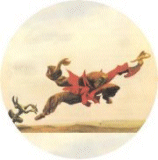
Contents ||| Study Tools |||
Classical Literature ||| Contact |||
Blog
Should I start writing immediately, or rather first decide the plot in details? How can I estimate the proper length? How can I handle the impressions I'd like to convey?
Edgar Allan Poe: The philosophy of composition
Page 10
I made the night tempestuous, first to account for the Raven's seeking admission, and secondly, for the effect of contrast with the (physical) serenity within the chamber.
I made the bird alight on the bust of Pallas, also for the effect of contrast between the marble and the plumage- it being understood that the bust was absolutely suggested by the bird- the bust of Pallas being chosen, first, as most in keeping with the scholarship of the lover, and secondly, for the sonorousness of the word, Pallas, itself. About the middle of the poem, also, I have availed myself of the force of contrast, with a view of deepening the ultimate impression. For example, an air of the fantastic- approaching as nearly to the ludicrous as was admissible- is given to the Raven's entrance. He comes in "with many a flirt and flutter."
Not the least obeisance made he- not a moment stopped or stayed he,
But with mien of lord or lady, perched above my chamber door.
In the two stanzas which follow, the design is more obviously carried out:
Then this ebony bird, beguiling my sad fancy into smiling
By the grave and stern decorum of the countenance it wore,
"Though thy crest be shorn and shaven, thou," I said, "art sure no craven,
Ghastly grim and ancient Raven wandering from the Nightly shore-
Tell me what thy lordly name is on the Night's Plutonian shore?"
Quoth the Raven- "Nevermore."
Cf. Rilke, Letter to a Young Poet | Plato, Whom are we talking to? | Kierkegaard, My work as an author | Emerson, Self-knowledge | Gibson - McRury, Discovering one's face | Emerson, We differ in art, not in wisdom | Joyce, Portrait of the Artist